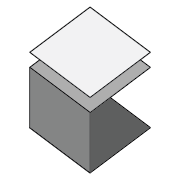|
Sculpting comes in a lot of different flavors, but whether youíre doing fine portrait replicas of you momís dog or making goofy cartoon characters, you still end up in the same clay hell. Unless youíre more into ZBrush, in which case God help you. What started as experimentation with a pack of discount Hobby Lobby sculpy will start you down a rabbit hole of wires, tubing, and epoxyóand if youíre REALLY into it, resin and moldmaking starts to come into play. Welcome to the sculpting thread! Sculpture? Like fine arts sculpture? Maybe, if youíre into that stuff! But sculpting isnít just for museumsóthere are plenty of personal or commercial applications as well! Ball joint dolls (any hobby doll, in fact), stop-motion maquettes, molds for soap or candymaking (they have to be sculpted first!), 3D printing models for machinery or art, collectable figures, mask and prosthetic design for filmÖthe list goes on and on. Once you start acquiring enough supplies to accomplish one thing, itís all too easy to leapfrog into another. Okay, so how DO you get started? First you need to decide what you want to create. There are different clays for different projects! Buying the wrong one can be a frustrating beginner error.  If you want to make silicone masks, castable prosthetics, or resin dolls/sculpts, you will want to invest in an unfireable oil-based clay. Oil-based clay is exactly what it sounds like: unlike water-based clay, it dries out incredibly slowly (over the course of years) and can be worked with for extended periods. Some, like Sculpey, will harden under heat the same as natural clay. For casting applications itís a good idea to get the unfireable kind, since you can heat it to pouring consistency, create addition effects with heat, and continue to reuse the clay for years. Iíve been told that Plastilina and Monster Clay are both decent and cost-effective brands to start working with. Another alternative is wax-based clay, which becomes totally hard at room temperature and allows for a completely different sculpting technique while still remaining reusable. If anyone has brand recommendations for that, Iíd love to add them up here!  If you want to make a stand-alone sculpt, or just donít want to sink an assload of money into the soul-crushing despair of learning moldmaking, good olí Sculpey has your back. Also oil-based, but it hardens under heat (even a little heatódo NOT leave this in a sunny car unless you want to sculpt a brick) and comes in a nice variety of hardnesses. The white sculpey is cheapest, and has the highest oil content; it has the longest shelf life and itís nice on a budget, but fine details are all too easily squished out of existence. The flesh tone is medium firmness, and the grey (my personal favorite) is both the most expensive and the best at holding detail. Sculpeys of different firmness are easily mixed together to an ideal consistency. Donít bother with the colored stuffóitís pricey and will rarely look as good as a coat of paint. Donít listen to the package firing instructions and fire it at 200 degrees for a longer period instead. You can cast a Sculpey figure, but it may be more difficult. If you want to create porcelain figures, clay masks, or anything with glazes, you will need to use water-based clay. Since this is a hugely diverse category and heavy water-based clay can be prohibitively expensive online, I would personally suggest you seek out a local studio or studio supplier and source your clay locally, based on their recommendation. In order to fire the clay properly you will also require a kiln, which you might be better off renting from a studio rather than buying. This is kind of another whole animal that deserves a post by itself. Firing water-based clay or ceramics is a pretty expensive and exact science, as opposed to the relative straightforwardness of oven-baking a Sculpey piece. Also important is your armature. Most clays will not support their own weight, and anything but the simplest sculpts will slowly sink if not internally supported. For facial sculpts or masks, the most support youíll need is probably just a mannequin head. For figures, you will essentially be creating a wire skeleton for your character. Many figurative armatures will use telescopic wiring for limbs and heads, allowing those parts to be removed for more precise and easy sculpt. For the base: -Aluminum wire, sized maybe 3/16 or 1/8 depending on your piece. Aluminum wire bends and cuts very easily, allowing for hassle-free posing, and doesnít heat up enough to damage Sculpey when baking. -Steel wire. Not all figures need steel wire, but if the pose is adventurous (on one leg, leaning heavily, etc.), aluminum alone will not hold the weight. Try and Ďliberateí a few political signs from peopleís front yards for an eco-friendly and cheap source! Steel is a bitch to bend, but that hour with a vice and hammer will be totally worth it, I promise. Might want to get a saw or dremel to cut this with. Steel, when it direct contact with Sculpey, may cause cracking and crumbling if fired at higher temperatures. -Small gage wire or flower wire. Youíll use this to fuse larger pieces of wire through binding, and in forming delicate extensions like fingers or long ears. -Super glue (and, if you wanna make your life easier, Zip Kicker). Super glue and a fast-setter like Zip Kicker go on top of small gage binding to further set connections. It is safe to heat to low temperatures, so always fire your Sculpey at 200f. -Plumberís epoxy. Apoxie Sculpt is great. Use this AFTER youíve posed your armature to really cement the connections in place. Like super glue, itís safe to heat to low temperatures. -A base. Freestanding sculpts are fun, but theyíre hard to move safely and you canít do super crazy poses with them. Youíll want to get a drill to anchor the armature wires into the wood. Get a SOLID WOOD BASEódo not get a plywood base or any chemically treated wood. You will most likely be baking your sculpture while on the base, and plywood releases dangerous chemicals under heat. A nice slab of pine, on the other hand, will just smell lovely at 200 degrees. -Assorted extras based on your sculpt, such as wire mesh, 7/32" and 3/16" square brass tubing, plumber's piping, etc. While you don't NEED them, rubbing alcohol and a sponge will help smooth clay, and finishing with sandpaper after firing is always a good idea. -Assorted tools to work with these materials, such as wire cutters, pliers, vice, a dremel, drill, and safety gloves + goggles for cutting. Real sticklers for proportions may also want a compass or calipers to measure the sculpt to make sure it matches up proportionately to your turnaround or reference, if you've chosen to make one. Yeah, but how do I actually sculpt? Actually sculpting goes a bit different for everyone, in terms of tools and methods. As long as your armature is solid you can always redo the actual sculpting portion, so don't stress too much when you're starting out. I sometimes like to start with drawing a turnaround, if it's a new character or precision is really important to me. After making your armature (a process that's take me up to 8 hours for really complex stuff), the next step is to bulk up your piece with tightly packed tinfoil. After pressing the foil on tight as possible, slab on a thin layer of clay and get to work! The tools you use will vary dramatically depending on which methods you settle into over time; a lot of folks swear by dental tools, but it still comes down to personal preference. To give you an idea, the sculpt I posted below was made with only a thumbtack, and an exacto knife, and my fingers, so you'd don't have to get fancy to make yourself happy. Trial and error will be more helpful than anything I recommend. Hereís a sculpt I recently did of a mad scientist character, photographed from rough armature to finished stage. The head, torso, and all four arms were removable: Armature (with telescopic tubing):   Posed, bulking out with aluminum foil:   Rough clay:  Finished:   Kind of rough, but it's a learning process! That was the third sculpt I've ever attempted, and the first telescopic one, so it was a success simply by not being a failure. If anyone has a level of experience with 3D sculpting, dollmaking, etc., please feel free to do a writeup on that, or submit some sources that you like! I'm eager to hear about those things from someone who knows them better. TheAbominableSnow fucked around with this message at 19:11 on Jun 3, 2015 |
|
|
|

|
| # ? May 6, 2024 09:35 |
|
Resources: To be updated once I finish the list
|
|
|
|
I'm excited to see this thread pop up! Unfortunately, my entire experience with sculpting has been a few ambitiously-bought packs of polymer clay that I've never managed to do anything with (beyond a tiny cupcake and a tiny ice cream cone that I made in college). I hold on to them in the hope that I one day will magically figure out how to make this happen, so I'm hoping others will jump in with proper experience.
|
|
|
|
Hey, no time to start figuring it out like now! I'm just posting figurative sculpts because that's what I know, but cute tiny food or critters belongs here just as much as anything else. You should give it another shot!
|
|
|
|
wow this is an amazing coincidence, my first package of sculpey Firm arrived yesterday and I have a bunch of new tools on order too. I'll be sure to follow and post progress shots of anything notable
|
|
|
|
Neat! I used to make little polymer clay animals to sell on etsy but then I got a Real Job and kind of stopped. Maybe this thread will be my inspiration to finally sit down again and try a big project like I always meant to.  If you want to cry about your own skills, this dude does some incredible work and has a ton of timelapse sculpting vids so you can see exactly how he does it: https://www.youtube.com/watch?v=channel?UCj3Rx2ZL5tP7pRd2qjbVYCQ
|
|
|
|
Wow I'm so excited to find this thread!!! I mostly use sculpy but I also sculpt in wool. Can I post that here too? Here's some of my recent stuff. I mostly make miniatures these days to sell in my Etsy shop.    
|
|
|
|
Everything posted in this thread is amazing 
|
|
|
|
I really love those cactus rings! (And your nails are super pretty too)
|
|
|
|
Guys, I am loving what you've all posted so far! Gonna have to echo the kudos on those adorable cactus rings--and even though they were posted AGES ago, that llama and cat are so cute!! Here's a project I 'finished' a while ago. I say 'finished' because I'm not super happy with how he turned out, so I'm going to redo him over the winter break. You can see the joint lines pretty clearly on him, but that's ok! He's going to be wearing a coat in the final rendition. Part of the reason I had so much trouble with him is because he needs to totally disassemble so I can put the sculpted clothes on him, despite the action pose. I ended up over-rendering his textures and the number of tentacles because I was so focused on just making him work, rather than taking the time to make sure he was working correctly.    Another reason I want to redo this guy is because he doesn't fit the cartoony style of the concept art I did:    I know that getting cartoon-esque smoothness and cohesive movement is going to be absolutely a bitch, especially on those tentacles (because I already failed that once), but I'm still excited to try him again! Except for that armature. The armature for this fucker took 7 hours last time so I REALLY hope experience will speed up the process the second time around.
|
|
|
|
That's incredible! The texture detail on his back is especially fantastic. How long did he take you overall?
|
|
|
|
I have a DIY crafty question and I guess this might be the best thread for it. It might be a little hard to explain properly: I have a plain white 12 in X 12 in canvas. I want a pure white material that I can build up in layers to about a .5 to 1 inch depth and sort of sweep around and have it dry with the sweeps frozen in place (think some lovely faux finish on a ceiling or wall or better yet Divinity Fudge/Candy - but less turbulent).  I'd frame the canvas with some temp wood or something so that, when dry, I'd remove it and the "walls" of the material would be nice and flat. Almost like the canvas is a cross section. It needs to be able to hang on the wall thus it needs to be lightweight as possible Dear god does that make any sense?
|
|
|
|
Plaster? I mean, that's what makes those finishes on walls.
|
|
|
|
Radio! posted:Plaster? I mean, that's what makes those finishes on walls. Yeah, I'm just not sure (as in totally unfamiliar) if plaster, built up to that depth, would be too heavy for a canvas hanging on a wall. I'll give it a shot though!
|
|
|
|
BonoMan posted:Yeah, I'm just not sure (as in totally unfamiliar) if plaster, built up to that depth, would be too heavy for a canvas hanging on a wall. My experience with plaster is limited to #1 pottery plaster for making sprig and slump molds. When cured it's not that heavy, I'll weigh one and give you an idea when I get to the studio today. When using plaster you need to figure out your target volume and then weight out the plaster and water. Wear a respirator. There is technique in mixing plaster and your working window will be fairly small. You have to let the crystals soak and you can under or over mix. I suggest 3 or more test batches of a quart target volume to practice your technique. I'm happy to share any knowledge I have with you. E: 14x14x2 of #1 pottery plaster weighs about 9lbs fully dry. EvilMayo fucked around with this message at 20:11 on Dec 15, 2015 |
|
|
|
Paperclay might work. You would probably have to experiment with your recipe to get the right consistency, but it's light, fluffy, and can take on either a tough or delicate texture depending on how you mix it. A lot of paperclay uses joint compound and/or plaster dust in the recipe so you should have a lot of options to play with. EDIT: holy poo poo, I'm sorry to have completely missed this Radio! posted:
He took about 60 hours, I'd say? A lot of that was due to inexperience because I'd never tried anything quite like him before. Texture tests for the redo have gone easily enough, so I think the second go will be quicker overall! Unless the new stuff I'm trying trips me up equally badly, of course. TheAbominableSnow fucked around with this message at 17:36 on Dec 15, 2015 |
|
|
|
Great thread and great OP! I've recently started sculping bigger stuff (1/6 scale heads) using Fimo with Tony Bartons headsculpts as an inspiration. There is a great tutorial here. What is your opinion on Milliput?
|
|
|
|
BonoMan posted:I have a DIY crafty question and I guess this might be the best thread for it. You might have luck with Sculpt-or-Coat or modeling paste! You have to work somewhat slowly and it may be slightly heavier than what you're looking for once it's dry, but it might give you the aesthetic you're looking for. Anyway, here's some ceramics.  Thrown yarn bowl for my sister, done in white clay with Mayco Floral Fantasy crystal glaze.  Krampus cup for holding my pens. Slab built in buff and glazed with Mayco Malachite.   Here's a slab pitcher before and after firing. I used the malachite glaze here as well and I wish I had a better picture to show off the color. It's a beautiful green with brown marbled through it. Guest starring the first coil cylinder I ever made  A Babadook steamroller pipe which unfortunately broke before it could be placed in the kiln.  And finally, here are some pendants I made to use as test tiles. I've become a total cookie cutter and stamp fiend after finding how easy these were to roll out and make. You can do the exact same with sculpey without waiting for the clay to firm up so you can stamp it without squishing it. Edit: phone posting, sorry if these are huge on a desktop! Grape Juice Vampire fucked around with this message at 17:49 on Dec 25, 2015 |
|
|
|
I started this morning trying out a form that has been bouncing around in my head. I attempted the base a few times and was unhappy with the result. The bottom was falling flat and the sides were buckling. I decided to first make a positive of the shape I wanted from clay then mixed plaster and poured a mold. After a quick lunch the plaster had set, I tore away the cardboard frame and cleaned the mold. This mold supports a cut and shaped slab allowing me to build up the sides and finish the bowl. Next I use a plumbing torch to firm up the clay and a stone to burnish the lip. The bowl is then turned over and a foot is made. I had planned using lugs to join the sides but really prefer the look of straps. Bringing a piece from imagination to reality is not a direct path. I have to remain flexible and listen to the clay.  
|
|
|
|
Are there still pottery goons browsing the forums? I've got a project where I may need to glaze something but I'm not quite sure where to start. I've got a pigmented glass powder that I need to coat and fuse onto a sheet of glass in a uniform manner. So far it seems like an enamel coating is basically what I'm after, is this my best option? Is it possible to get matte enamels or will they always be glossy?
|
|
|
|

|
| # ? May 6, 2024 09:35 |
|
Rozzbot posted:Are there still pottery goons browsing the forums? I've got a project where I may need to glaze something but I'm not quite sure where to start. I've done some enamel work on jewelry. You get a matte finish by slightly under-firing the last layer. I believe this is the same with pottery glazing. (I'll double-check with my wife, who is a potter, when I get home). Other option could be to wash the surface in acid, but apart from knowing that it was possible, I never looked into what it actually required. Your problem, however, is that by having it fusing into a sheet of glass, you will also approach the melting temperature of the glass. Not sure how easy that will be to manage.
|
|
|

















